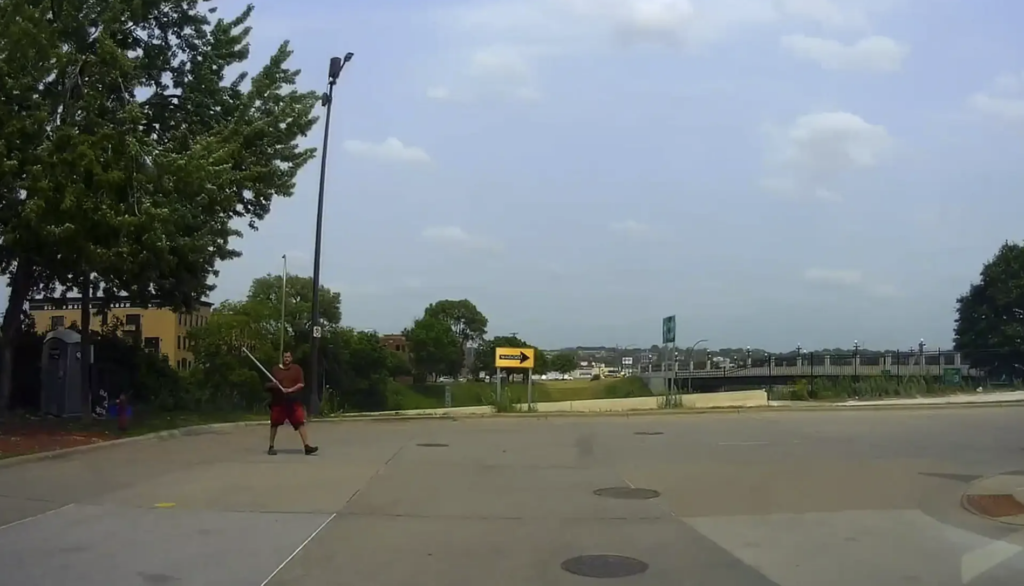
This picture was captured from a dashcam video sent to me by a friend, documenting an actual recent drive to work. Take a look at it just briefly, as if through a windshield, then scroll back here and read on.
Did you see the man on the left? What can you tell me about him? To me, he looks like he’s holding some sort of stick like a baseball bat. It’s difficult to see his expression, but less so to see that he is already in the street and still moving. From a safety perspective, that’s all you and I need to know. Exactly what he’s holding and why isn’t particularly important in the moment. The potential that a person might try to hit our vehicle with an unknown object should be enough to trigger a response and for my friend, it did. They drove past the man on the street, who tried to hit the vehicle, so my friend accelerated away, safely running a red light to create distance before calling the police to report the incident.
After the fact, we can all wonder who that man was and what they were trying to do. The obvious explanation is that he wanted to hurt someone or something, and was waiting to swing away at passing vehicles to either damage them or provoke a fight. If we had some context about the location, we might know about a homeless encampment nearby that may include one of the rare violently mentally ill, or a gathering of protesters or rioters who might not care who is in their way. If we had more than a quick glance, we might be able to tell if he was under the influence of alcohol or drugs. If we could read minds, we might know that he had a vendetta against sedans but not pickup trucks, or that he was waiting for his ex-wife to drive by, or that he was running away from an attacker of his own, or that the stick wasn’t anything at all and he just wanted to ask for some truly-needed food or money. If we’d been there before or after, we might know that the man was doing nothing than wandering through the street, perhaps swinging his stick, but not interested in hitting anything at all. One of those scenarios might be actually problematic for us, and another might mean we were in no danger at all. Figuring that out in hindsight is an interesting exercise, perhaps useful for preventing or dealing with future folks from being out in the street swinging sticks, but unnecessary now.
Instead, what’s more important right away is to figure out what to do about the potential issue you’ve spotted, and how that might change depending on how he acts. There are several options that I’m sure you can think of, while you’re scrolling through social media just now. You could, as my friend did, hit the gas and get somewhere else as quickly as safely possible. You can try to leave the area with more urgency or less. You could decide that will only be your course of action unless and until the man moves to within a certain distance of you, makes a more overtly threatening gesture, or physically makes contact with your vehicle. You could decide to yell at him through a closed window, call the police, or prepare to use a weapon, even actually make a weapon visible. You could think about whether you’d stay inside or get out and confront the man if and when he damages your vehicle, and how you’d manage him if he tries to stand in your way. You could consider stopping and opening your window if it turned out the man was someone who needed your help. Running through all of your choices now will help reduce the amount of time you spend wandering through those ideas if you see this guy for real.
My friend’s course of action was a well-planned and smart one. They had already decided that if they saw a potential threat on foot while they were driving, they would focus on staying in their vehicle and getting away swiftly no matter what happened. Because that was their plan, they already had the skills and mindset in place to do so safely and without panicking. They already made peace with the fact that their vehicle could be damaged, and knew that they would drive away anyway instead of hopping out to confront the attacker. It was a perfect example of “decision tree pruning,” which is a way of simplifying and classifying data to make it easier and faster to figure out where a new input fits and what output goes with it. The tree wasn’t so bare that there was no room for changing responses because the exhibited action was a middle ground that could allow for ramping up and down. The tree also wasn’t so complex that a different response would be necessary if the man was holding a large branch versus a metal pole, requiring discernment of minute details before proceeding with a course of action.
Imagining all of the different scenarios this picture might represent is an important exercise for your safety, so that you can imagine all of the different responses you might choose and the consequences of those responses. I encourage you to be creative in thinking about the possibilities, so that you are less likely to be surprised into an unplanned reaction by the reality. I also encourage you to be creative with thinking about what you can do, because it’s not until the next step where you should worry about whether you have the requisite skills or are comfortable with the social, emotional, or legal fallout. At that time, you can explore how you can overcome the obstacles to bringing an option into play or discard that option entirely and go back to the drawing board. Going through this process when you are comfortable and have time means that you will be able to prune that decision tree and be able to navigate it smoothly and confidently when it matters, instead of flailing about and doing something you may regret later. Expanding on this process with other, similar images (like the ones available in the decks from Image Based Decisional Drills) will help prepare you for more situations, and make it less likely you’ll run into one for which you have no idea what to do. Not only will you feel safer knowing that you have an action plan for most anything, you will be safer because that plan will be ready to go.





